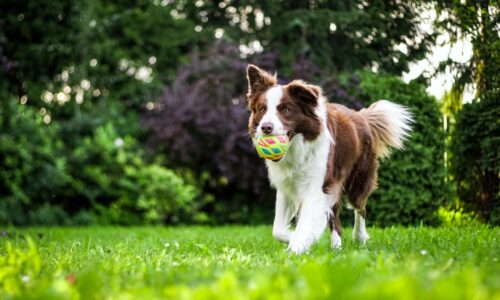Anxiety affects all breeds and ages, but it affects every dog differently. It’s an unpleasant but physiological emotion that every dog experiences from time to time. If not corrected and addressed, the dog can develop an anxiety behavior disorder that leads to other behavioral problems. Triggers can be a variety of things, from improper puppy socialization to traumatic experiences or genetics. Most fears and phobias develop in dogs between the ages of 12 weeks and 36 months and follow dogs throughout their lives.
The most common causes of dog anxiety are fear, separation and aging. Anxiety due to fear is caused by loud noises, unfamiliar people or animals, visual stimuli such as umbrellas, sticks or specific situations such as going to the vet, untrained driving in a car. A large number of dogs have milder anxiety reactions to these conditions, but in some the consequences are much more severe, especially if the owner does not commit to solving the problem in the beginning. For example, a dog not trained to drive in a car vomits on the seat, the owner reacts angrily and continues to drive the dog in the trunk. The dog will be reluctant to get into the trunk and over time driving the car will become a problem. For another example, we can cite a situation when a puppy reacts scared to an unknown man with a hat (e.g. postman), the owner finds it funny and continues to scare the puppy with the same situation, and later the dog will react defensively every time he finds himself in the same situation.
Separation anxiety affects approximately 14% of dogs. Such dogs cannot calm down when left alone or when separated from their family members. It usually manifests itself in undesirable behavior such as defecating in the house, destroying furniture or barking continuously. It is more common in dogs that have been repeatedly abandoned or neglected. Age-related anxiety is closely related to canine cognitive dysfunction.
The most common clinical signs of dog anxiety are shaking, dilated pupils, avoiding eye contact, fidgeting, ignoring, yawning, licking, sniffing the air, shaking the body as if the dog is wet, folded tail, looking for an exit, hiding, aggressiveness, defecating in unusual places, drooling, panting, destructive behavior, depression, excessive barking, restlessness, pacing, repetitive or compulsive behavior (licking body parts, paw or tail biting, circling and tail chasing). Some of the signs occur occasionally, some more often and connect to each other and become a bigger problem.
When dealing with canine anxiety, the owner is referred to trainings that include desensitization and counterconditioning. The idea of counterconditioning is to change the dog’s focus from the anxiety stimulus to the owner. Desensitization is an approach in which the owner gradually introduces the dog to the source of fear, in smaller time intervals and with reduced intensity. Since most owners are not sufficiently familiar with the problem, it is recommended that they turn to professional dog trainers who are up to such problems.
In practice, antidepressants, such as fluoxetine and clomipramine, are often prescribed to treat the disorder. For anxiety disorders that can be predicted, thunderstorms, fireworks or long drives, benzodiazepines are used, alone or in combination with antidepressants. Natural preparations include pheromones, aromatherapy and CBD oil. Antidepressants must be started at least one month before the expected phobia, and after that the dog is gradually taken off the therapy (a common treatment for Christmas-New Year anxieties related to firecrackers). Benzodiazepines are used 30-60 minutes before the expected stimulant, but it should be remembered that sometimes they simply do not work. There are also various natural preparations and food supplements, but they must also be taken for a certain period before the expected stress.
One of the best ways to predict your dog’s anxiety attack is to learn your dog’s body language. Knowing your dog and understanding when he is uncomfortable and scared can help avoid negative experiences or turn them into positive ones by choosing good training. Working with a dog is extremely important, the basics of obedience are necessary. Regular exercise and walks are extremely important for a dog’s mental and physical development.
Phobias in dogs are excessive and persistent fear of a specific stimulus. It is considered that one phobic event is enough for any similar or mere reminder of the event to cause fear. The most common phobias in dogs are closely related to noise, such as fireworks or thunder. Approximately 49% of dogs have a phobia of fireworks and the noise associated with gunshots and firecrackers.
Storm phobias in dogs are also one of the bigger problems. Both people and animals will react to sudden lightning and flash. Fear is a physiological defense of the organism. However, with a phobia, dogs will react when they notice that the sky has darkened or hear thunder in the distance, and the symptoms do not subside even after taking refuge. In such dogs, anxiety disorders occur to wind, rain, thunder, lightning, but also changes in pressure, the smell of an approaching storm, changes in the static electricity of the air. One study found a 207% increase in cortisol (the stress hormone) in dogs’ saliva after exposure to a storm.
How to help a dog with a phobia of storms? Provide a safe place during the storm, provide background noise (television, radio, white noise), offer the dog a safe place of its own choosing (closet, cage, bathtub). The treatment of this phobia is extremely difficult considering that dogs react to invisible stimuli such as air ionization and changes in atmospheric pressure.
In some dogs, the possible cause of anxious behavior is an undetected disease of the thyroid gland, adrenal gland or brain, so it is advisable to check the general condition of the pet with a systematic examination. Treatment of the problem is long-term and a minimum of 4-6 months is required for the first visible results. It should be borne in mind that drug therapy is a last resort and does not suit every animal. Also, taking medicines implies more frequent blood tests to make sure that the medicines do not harm the organs. It is important to note that locking dogs in a box or cage does not suit all dogs. Some will happily retreat to a safe zone while others will have even worse panic attacks. In any case, a dog with a phobia or fear should never be punished for its behavior.
A large number of dogs suffering from anxiety and phobias respond well to wraps and shirts designed to stimulate acupressure points.




